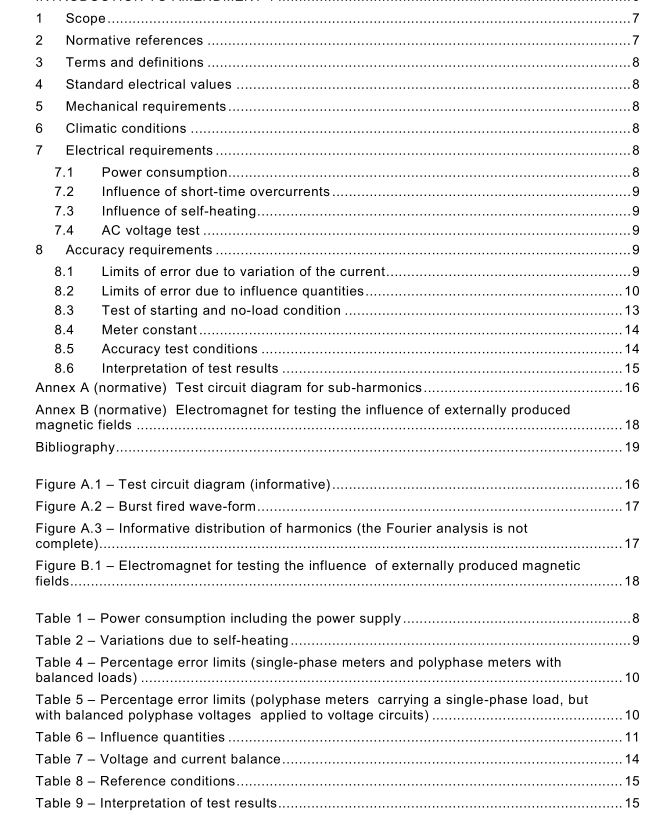AS 62053.22 pdf download – Electricity metering equipment (ac)— Particular requirements Part 22: Static meters for active energy (classes 0.2 S and 0.5 S) (IEC 62053-22:2016 (ED. 1.1) MOD)

AS 62053.22 pdf download – Electricity metering equipment (ac)— Particular requirements Part 22: Static meters for active energy (classes 0.2 S and 0.5 S) (IEC 62053-22:2016 (ED. 1.1) MOD)
1 Scope
This part of lEC 62053 applies only to newly manufactured static watt-hour meters ofaccuracy classes 0,2 s and 0,5 S, for the measurement of alternating current electrical activeenergy in 50 Hz or 60 Hz networks and it applies to their type tests only.
lt applies only to transformer-operated static watt-hour meters for indoor applicationconsisting of a measuring element and register(s) enclosed together in a meter case. It alsoapplies to operation indicator(s) and test output(s). lf the meter has a measuring element formore than one type of energy (multi-energy meters), or when other functional elements,likemaximum demand indicators, electronic tariff registers, time switches, ripple control receivers,data communication interfaces,etc. are enclosed in the meter case,then the relevantstandards for these elements also apply.
NOTE IEC 60044-1describes transformers having a measuring range of 0,01ln to 1,2l., or of 0,05 l, to 1,5 l., orof 0,05 ln to 2 1n and transformers having a measuring range of 0,01 ln to 1,2 l。for accuracy classes 0,2 S and0.5 S.As the measuring ranges of a meter and its associated transformers have to be matched and as onlytransformers of classes 0,2 S and 0,5 $ have the accuracy required to operate the meters of this standard,themeasuring range of the meter will be 0.01 。to 1,2 「n.
lt does not apply to:
watt-hour meters where the voltage across the connection terminals exceeds 600 v (line-to-line voltage for meters for polyphase systems);
portable meters and meters for outdoor use;
– data interfaces to the register of the meter;- reference meters.
The dependability aspect is covered by the documents of the lEC 62059 series.
The safety aspect is covered by lEC 62052-31:2015.
Regarding acceptance tests,see IEC 62058-11:2008 and lEC 62058-31:2008.
2Normative references
The following referenced documents are indispensable for the application of this document.For dated references, only the edition cited applies. For undated references, the latest editionof the referenced document (including any amendments) applies.
IEC 60044-1:1996,Instrument transformers – Part 1: Current transformers
IEC 62052-11;2003,Electricity metering equipment (AC) – General requirements, tests andtest conditions – Part 11 : Metering equipment
Amendment 1 (2016)
IEC 62052-31:2015,Electricity metering equipment (AC) – General requirements,tests andtest conditions – Part 31: Product safety requirements and tests
IEC 62053-61 :1 998, Electricity metering equipment (a.c.) – Particular requirements – Part 61: Power consumption and voltage requirements
3 Terms and definitions
For the purposes of this document, the terms and definitions given in IEC 62052-1 1 apply.
4 Standard electrical values
The values given in IEC 62052-1 1 apply.
5 Mechanical requirements
The requirements of IEC 62052-1 1 apply.
6 Climatic conditions
The conditions given in IEC 62052-1 1 apply.
7 Electrical requirements
In addition to the electrical requirements in IEC 62052-1 1 , meters shall fulfil the following requirements.
7.1 Power consumption
The power consumption in the voltage and current circuits shall be determined at reference conditions given in 8.5 by any suitable method. The overall maximum error of the measurement of the power consumption shall not exceed 5 %.
The active and apparent power consumption taken at reference temperature and reference frequency, by each voltage circuit at reference voltage and by each current circuit at rated current, shall not exceed the values shown in Table 1 .
7.2 Influence of short-time overcurrents Short-time overcurrents shall not damage the meter. The meter shall perform correctly when back to its initial working condition and the variation of error at rated current and unity power factor shall not exceed 0,05 %. The test circuit shall be practically non-inductive and the test shall be performed for polyphase meters phase-by-phase. After the application of the short-time overcurrent with the voltage maintained at the terminals, the meter shall be allowed to return to the initial temperature with the voltage circuit(s) energized (about 1 h). The meter shall be able to carry for 0,5 s a current equal to 20 I max with a relative tolerance of +0 % to –1 0 %.
7.3 Influence of self-heating The variation of error due to self-heating shall not exceed the values given in Table 2.









